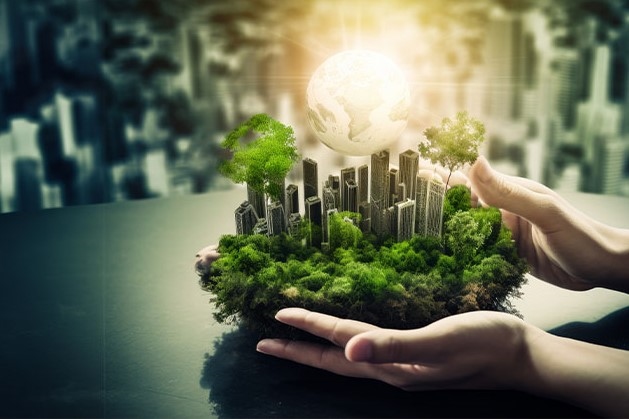Green Growth in the News Real Estate World
The real estate industry is experiencing a transformative shift toward environmentally conscious development. Increasingly, buyers, investors, and developers are prioritizing sustainability, signaling a new era of green housing growth. This shift reflects a broader societal demand for properties that not only meet functional needs but also contribute positively to the environment and communities in which they exist.

The Rise of Eco Real Estate
Eco real estate is no longer a niche segment. Modern buyers seek properties designed with energy efficiency, renewable resources, and environmentally friendly materials in mind. Solar panels, smart thermostats, and water-conserving systems are becoming standard expectations rather than optional features. Eco real estate caters to those who value both long-term savings and ecological responsibility, and this demand is reshaping market priorities.
Cities and urban centers are witnessing an influx of eco real estate projects. Developers are investing in green roofs, vertical gardens, and sustainable landscaping to enhance air quality, reduce heat islands, and improve residents’ quality of life. These environmentally conscious design choices create properties that appeal to a growing demographic of environmentally aware homeowners and renters.
Sustainable Property Development
The concept of sustainable property goes beyond individual buildings. It encompasses entire neighborhoods, developments, and infrastructure systems designed to minimize environmental impact while maximizing livability. Smart energy grids, efficient public transportation links, and low-impact construction practices are essential elements of sustainable property initiatives.
Developers integrating sustainable property strategies not only meet regulatory requirements but also position themselves competitively in a market that increasingly values long-term sustainability. Properties designed with resilience in mind often retain higher value, reduce operational costs, and attract tenants and buyers who prioritize eco-conscious living.
Green Market Shifts and Investment Opportunities
Green market shifts are influencing investment decisions and shaping the trajectory of the real estate sector. Investors are increasingly factoring environmental performance into their valuation models, recognizing that properties with green certifications or energy-efficient systems are likely to experience higher demand and appreciation.
The surge in green market shifts is also evident in financing trends. Banks and financial institutions are offering incentives for eco-friendly projects, including lower interest rates, green bonds, and preferential lending for sustainable developments. This financial backing accelerates adoption of green initiatives and encourages innovation across the property sector.
Residential and Commercial Impacts
In the residential sector, green housing growth is driven by a combination of lifestyle preference and economic pragmatism. Homebuyers are attracted to lower utility costs, healthier indoor environments, and long-term property value retention. Energy-efficient appliances, insulation, and passive design elements contribute to both comfort and financial savings, making green housing growth a practical choice for modern families.
Commercial real estate is also embracing sustainability. Companies increasingly seek office spaces and retail environments with environmentally responsible design and operational efficiency. Tenants are drawn to buildings with LEED certifications, green technologies, and sustainable amenities, reinforcing the market shift toward eco real estate.
Urban Planning and Community Integration
Green development is not limited to individual structures; it extends to urban planning and community integration. Cities embracing green market shifts prioritize public parks, pedestrian-friendly infrastructure, and cycling networks. Mixed-use developments with energy-efficient designs encourage walkability, reduce transportation emissions, and foster a sense of community.
Developers adopting this holistic approach to sustainable property create neighborhoods that are both environmentally responsible and socially vibrant. These initiatives not only attract buyers and investors but also enhance the long-term livability of urban centers.
Challenges and Opportunities
While the push for green housing growth presents exciting prospects, it also comes with challenges. Initial construction costs for sustainable buildings can be higher, and sourcing eco-friendly materials requires careful planning. Regulatory compliance and certification processes may also extend project timelines.
However, the long-term benefits outweigh the initial hurdles. Eco real estate and sustainable property projects tend to experience lower operating costs, higher tenant retention, and increased market resilience. Investors and developers who anticipate green market shifts early gain a competitive edge, positioning themselves at the forefront of the evolving property landscape.
Technology Driving Green Growth
Technology plays a pivotal role in advancing green housing growth. Smart building management systems monitor energy consumption, optimize heating and cooling, and reduce waste. Data analytics help developers and investors identify sustainable design opportunities, assess environmental impact, and forecast financial returns for eco-conscious projects.
Additionally, emerging innovations in construction materials, such as recycled composites and low-carbon concrete, support the rise of sustainable property development. By integrating these technologies, developers can deliver environmentally responsible properties without compromising on quality or aesthetic appeal.
Global Influence and Policy Support
Internationally, green market shifts are being reinforced by government policies and global sustainability initiatives. Incentives for energy-efficient construction, tax credits for renewable energy integration, and stricter environmental regulations are shaping both residential and commercial development patterns.
Countries with robust environmental frameworks encourage eco real estate growth while setting benchmarks for innovation. Investors and developers attentive to these trends can leverage policy support, access financial incentives, and meet growing consumer demand for green living.
The Future of Green Real Estate
The trajectory of the real estate market indicates that green housing growth is more than a trend; it is a paradigm shift. Properties that integrate sustainability, energy efficiency, and community-focused design are becoming the standard rather than the exception.
As eco real estate expands, the industry will continue to innovate, with new technologies, materials, and design principles driving future developments. Sustainable property solutions will not only address environmental concerns but also enhance market value, tenant satisfaction, and long-term resilience.
Conclusion
The real estate world is witnessing an era of green housing growth, fueled by demand for eco real estate and sustainable property. Green market shifts are transforming residential and commercial landscapes, influencing buyer preferences, investment strategies, and urban planning decisions.
Embracing these changes allows developers, investors, and homeowners to align profitability with environmental stewardship. The path forward is clear: the future of real estate is green, innovative, and interconnected, offering opportunities for those ready to integrate sustainability into every facet of the market.






